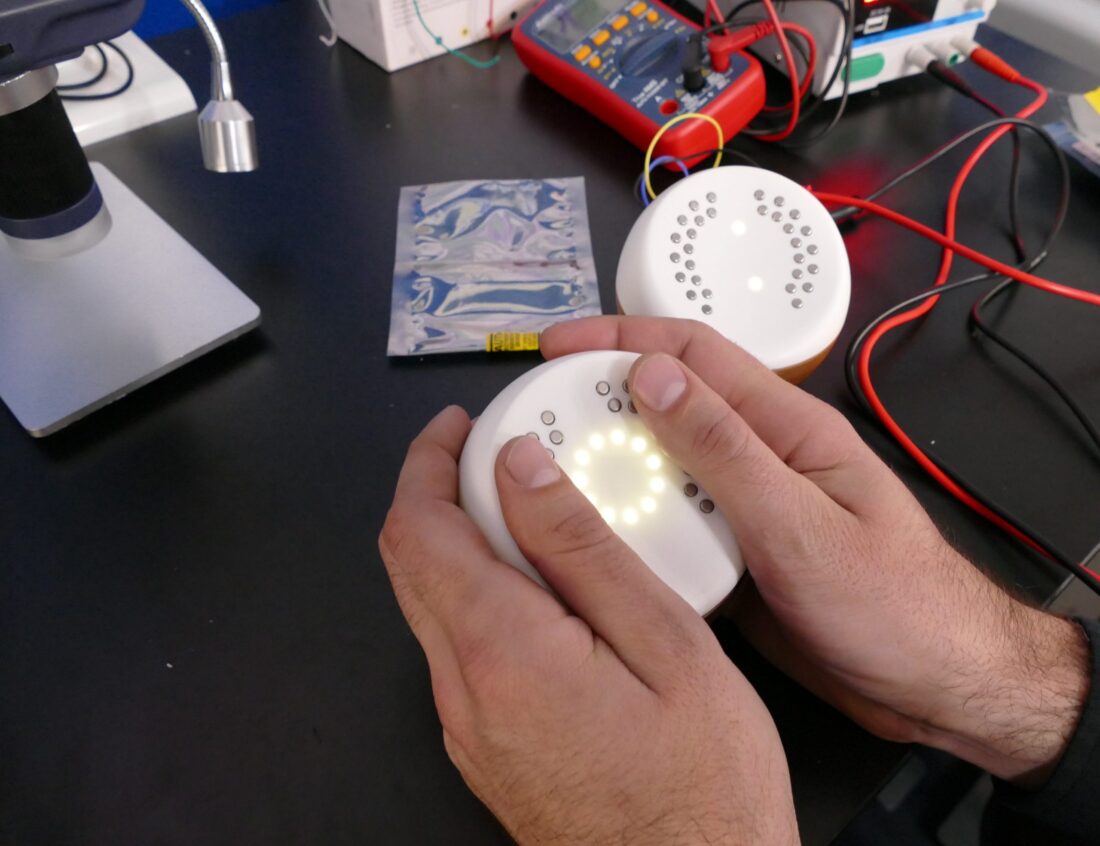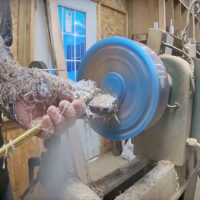We saw Core, a “meditation trainer”, popping up all over at CES 2020, covered here! Now, they’re sharing the physical product engineering challenges behind creating this wellness device. And there were MANY engineering prob… er, lessons to be learned.
Watch the video below to see our interview with Sara Weber, Director of Marketing & Partnerships, and Bashir Ziady, VP of Engineering.
Disclaimer for Media Integrity-type Purposes: Core is a client of my optical engineering company, Spire Starter LLC. (It has parts that light up and where there’s light, there are optics.) Therefore, my overall opinion on the product will be totally biased. The engineering lessons below, however, are untainted.
What is This Thing?
Sara Weber, Director of Marketing & Partnerships, sat down with us to explain why they built this gadget.

It turns out learning how to meditate and getting better at it can be hard! With guidance and METRICS, however, it becomes a lot easier to build a meditation practice. After all, “what gets measured gets managed.”
I thought it would be a great product for all the stressed-out engineers I know — which is most of the engineers I know. (Remember, only us engineers suffer from The Engineer’s Curse.) First, it’s a cool tech toy to play with. Second, it’s a tool to give you biometric feedback on how well you’re progressing on your very important learning-to-chill journey.
What Does Core Do?
The physical product pairs to an app that provides audio guidance throughout a meditation. The user holds the device while getting into meditation mode and it provides additional guidance with haptics. It also simultaneously measures heart rate and heart rate variability. Then, it sends that data back to the app to log.
Beyond the real work it’s doing when vibrating, lighting up and collecting data, the device serves a purpose when sitting idly on your end table. Simply by being a physical presence in your 3D field of view, Core becomes a passive reminder. I never thought of this value that a physical product can bring before!
What’s Inside

This product has a lot of interesting parts. For one thing, Core’s base is real wood to add to that aesthetic appeal. That’s something I rarely see in the world of hardware startups. It also has lighting elements seen through the top face of the device. On the top right and top left of the product are bunches of metal dots and each bunch is a dry electrode — one for each thumb. This part collects data about how your heart is beating. Finally, hidden from view are the motorized electronics to provide haptic feedback by making the entire orb vibrate.
What is HRV? Why Should I Care?
If you’ve never heard of the term “heart rate variability” (HRV), you’re not alone. It’s a metric I’d never encountered in hardware engineering before, either. HRV is a measure of how closely your heart is keeping to the same number of beats per minute. If it beats precisely once per second on the second, that has a lower variability than if it was, say, 60 bpm (beats per minute) for 10 seconds and then 70 bpm for 15 seconds, then 55 bpm for 12 seconds.
Counterintuitively, a higher amount of variability correlates to less stressful states of the body. Yeah, you read that right. The more the beat of your heart skips around, the less stressed you are. When the heart is attentively drumming along with the precision of a Swiss clock, it’s actually on high alert. When it gets lazy and lets its rhythm slide, it’s more chillaxed.
Another surprising thing about HRV is that it’s a more reliable metric for predicting states of high stress than plain old heart rate is. So, now that’s a thing you know.
Engineering Challenges
Bashir “Bash” Ziady, VP of Engineering, walked us through many engineering lessons encountered when designing this product. This segment starts at marker 3:38 in the video.

I was impressed by how much consideration Core made about fine-tuning specs, and soliciting user feedback which they actually used to make design changes. (You can’t see it, but right now, I’m making my genuine amazement face.)
I imagine this is in no small part due to the fact that this was not Ziady’s first time at the races. He’s a seasoned HW guy, and it shows. One of his earlier claims to fame is working on the hardware for, *gasp* Guitar Hero. Legend.
Developing Dry Electrodes
If you’re having your heart rate and its variability measured in a hospital, you’d likely see a large electrocardiogram (ECG) machine wheeled in to do the job. Then, gel-coated electrodes would be stuck directly to your bare skin. While Core didn’t require hospital-level ECG precision, shrinking the capability down to a hand-held device was still a big challenge!

The metal composition matters a LOT. The team at Core learned this lesson on an earlier prototype run where a Chinese factory just used whatever material they had on hand instead of what was spec’d. It did not work well.
Of course, that’s been cleaned up at this point and with the correct material in place, those electrodes work very well. Takeaway: when problems arise, always check that your vendor really did the thing you asked them to do.
Incorporating Natural Wood into a Mass-Produced Physical Product
Ziady told us that using real wood in a product design at volume is very tricky. But why?
“Tolerances are real.”
Bashir Ziady on why producing several thousands of a product using wood is tough.
Oh, right, OK.
Wood won’t keep tolerances well as the material tends to expand and contract with changes in humidity and temperature. It also doesn’t expand in all directions evenly. Along the grain axis, you’ll get different amounts of expansion than across the grain. So how does one design around all this variability?
Finding High-Quality CNC Vendors
Ziady told us one of the keys to incorporating wood into this device was finding good CNC vendors. It was important that they were highly experienced in working with wood, could do it well, and could do it on a large scale. Just because a vendor can get 100 parts within spec, doesn’t necessarily mean they can do it for several thousand parts.
Type of Wood
The choice of wood ended up being a very important design consideration for this product.
First off, all types of wood have varying expansion properties and ability to keep tolerances when cut. Another thing the team at Core had to look out for was that some wood types looked like a hot mess when it was cut into. They found some woods had high variability in appearance, and ugly grain structures could emerge when they were cut into. A third factor was wood density. Woods that are denser just feel like a nicer, more substantial base for their product. Denser wood also tends to expand less as one might expect with fewer pockets for water to creep into.

Ultimately, Core went with the dense and visually satisfying choice of rosewood.
Mechanical Design
To minimize the negative effects of expansion, a best practice is to remove as much material as possible in your design in areas where you need to account for tolerance stack-up. So, this rule should especially be applied to areas on a part where you’re connecting wood to the rest of the hardware.
Ergonomics – “Hands Are Weird”
“Biomorphology is a strange thing,” Ziady told us when I asked why it was so tough to get the housing shape right.

The curvature of the top rim could be irritating to your thumbs after a while if it was too high in certain spots. At the same, if the top face didn’t have a steep enough angle, your thumbs would need to bend down too much to reach the electrodes. There again, the shape could lead to irritation after prolonged use. In the end, the only way to dial in the final, ergonomic housing shape was to get feedback from hundreds of product testers and iterate.
Getting the Haptics Right
Just like with getting an outer shape that feels pleasing to thousands of different hands, getting the right amount of buzz in the haptics turned out to be a similar challenge. Too much, and you’ll get irritated. You might even experience that lingering vibration sensation like after you use a lawnmower for a long time.
In the opposite direction, the minimum threshold sensation that people can detect varies. So, they had to make sure it was also enough vibration for everyone to know when it was buzzing.
The third thing to make the haptic setting a challenge was – Core is a hefty little doohickey. It contains a lot of mass that needs to be displaced for a user on the outside to feel the sensation. In the end, a lot of user testing from a large group of people helped to dial in this spec, too.
Iterations. Lots and Lots of Iterations.

Can we all just take a moment and look at what truly well-done product development looks like?
I talk with many hardware startups that have a working prototype or a 2nd iteration and are confident they are good to go with making 100,000 of the thing with no user testing. *Insert facepalm.* In the image above, we see just a glimpse of the development path of Core’s product. It was based on getting feedback from hundreds of users and then iterating…many times! A startup may not need exactly this many iterations, but can we agree that more than 1 would be a lovely idea to start with?
HW Development Advice from Bash to His Earlier Self
Keep your friends close but your vendors closer.
Ziady’s best tip to his earlier self if time traveling were a thing.
Having vendors who would go the extra mile and do custom work beyond a normal offering was very important in this project. It’s especially valuable when your company is “small and scrappy”. So make sure you have excellent working relationships with those vendors! They might save your hide.
Core JUST Launched!
Core announced during CES 2020 they are ready to be purchased. You can go here to order yours now.







